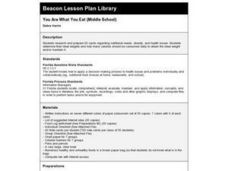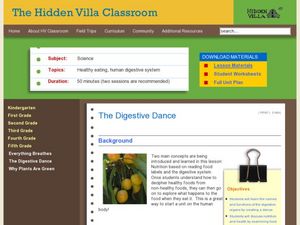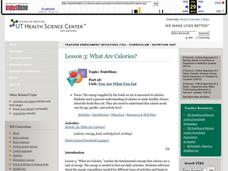Curated OER
Get Fit for Yosemite - Nutrition
Students demonstrate an understanding of healthy eating habits and of following a fitness program. They visit Yosemite Institute.
Curated OER
The Secreat to Good Health: Eating Right and Exercise
Students create a seven-day record of all the foods they consume. They analyze what type of food was the most frequent in everyone's diet. They look up each food and record its daily recommended amount.
Curated OER
Eating Well and Keeping Fit
Learners look at statistics that show children who are overweight are increasing in our society. Students chart out ways to be physically active and how to eat a balanced diet. Learners devise a menu/activity chart in light of what has...
Curated OER
You Are What You Eat (Middle School)
Third graders determine what their ideal weights should be and how many calories should be consumed daily to obtain the ideal weight and/or maintain it. They research and prepare 20 cards regarding nutritional needs, obesity, and health...
Curated OER
Nutrition
Student analyze pictures of food items to determine which of the six food pyramid groups they belong to. They tape the pictures onto a poster of the food pyramid. Upon completing the food pyramid, they draw balance meals on paper plates...
Curated OER
Working Worms
Students study earthworms and their role in creating healthy soil for healthy food. In this earthworms and soil lesson, students complete an jug experiment to learn about the role of earthworms and healthy soil. Students read and discuss...
Curated OER
Nutrition
Third graders explore the components of a balanced diet and practice making healthy diet choices. They discuss health-enhancing choices. Students investigate the food pyramid and how to use it to make educated menu decisions. They...
Curated OER
Get the Skinny on Milk
Students identify the different types of milk available in the market. In this adult health science lesson, students compare their nutrition information. They read milk labels and analyze the nutrients in it.
Curated OER
Calorie Countdown
Fifth graders analyze their caloric intake and energy output. In this nutrition and health lesson, 5th graders use the Dietary Guidelines for Americans to evaluate their personal food intake and activity level. Students explore the...
Curated OER
The Six Nutrients Student Worksheet
In this health worksheet, learners answer ten questions based around the concept of the different types of foods like carbohydrates, proteins, and fats with an emphasis upon how they are used in the body.
Curated OER
Fruits and Veggies More Matters: Teen Lesson
Learners study the importance of increasing their fruit and vegetable consumption. In this healthy diet lesson, students study the benefits of eating fruits and vegetables based on their age, sex, and activity level. Learners list three...
Curated OER
My Pyramid
Tenth graders analyze the new Food Guide Pyramid. In this healthy diet lesson, 10th graders explore the the website with the new food pyramid. Students use magazines to find foods from the food groups and create their own pyramid....
Curated OER
Try Something New! Enjoy the Great Taste of Whole Grains
Students share their shopping experience with the new WIC whole grain check. In this adult health lesson, students explain the proper way to prepare whole grains. They watch a cooking demo on a new recipe and implement it at home.
Curated OER
Nutrition: Why do we need rice in our diet?
Second graders discover what the Food Guide Pyramid represents. In this health lesson, 2nd graders experience the types of foods represented in each of the groups found in the pyramid. As part of this lesson, students discover one food...
Curated OER
A Funky Healthy Life Style!
Learners name the five food groups and classify foods according to group. They tell how proteins, carbohydrates, vitamins/minerals, and water help their body. Students discuss how play and exercise can help their body.
Curated OER
Healthy Foods
Students illustrate their favorite food and add it to a food pyramid graph, after listening to Russell Hoban's story, Bread and Jam for Frances.
Curated OER
Eat Your Sprouts Part I
Students will conduct a lab on the oxidation of an apple. The students will learn that the oxidation process can be halted when lemon juice is applied to the flesh of an apple because the lemon juice contains vitamin C, an antioxidant....
Curated OER
Nutrition (Low Fat/High Fat Foods)
Students explain that a low fat diet, accompanied by being physically active, help them live longer and healthier lives.
Curated OER
Good Enough To Eat
Students are introduced to the five food groups. In groups, they place different foods into the correct section of the Food Pyramid. Using different types of technology, they create one page of a class ABC book sharing what they know...
Champions for Change
How Many Cups Do I Need?
Does an apple a day really keep the doctor away? Find out by browsing through a variety of handouts and learning the recommended daily amounts of fruits and vegetables for good health. Learners will read and discuss how to visually...
Curated OER
The Digestive Dance
Students read food labels to compare healthy verses non healthy food and then use diagrams to create a poster of the digestive system. In this food lesson plan, students move the food down the digestive track along the digestive system.
Curated OER
Plan a Meal Fun
Discuss helping with the family grocery shopping. View a teacher drawn map of a grocery store and discuss where the breads, meats, and dairy products are located. Practice categorizing foods as breads and cereals, fruits, vegetables,...
Curated OER
Why is Rice Good for Us?
Third graders explore why rice is good for our bodies. In this nourishment lesson, 3rd graders review the food pyramid and discuss serving sizes. Students discuss the different ways rice is used in food. Students use uncooked rice to...
Curated OER
What Are Calories?
Students examine calories for the human body. In this calorie instructional activity, students explore the energy expenditures needed for different types of activities and how many calories are needed to support daily functions.

























